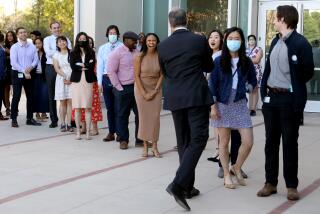Op-Ed: Even as more Asian Americans become doctors, workplace bias flourishes

- Share via
The operating room nurse, a trim, muscular white man in his 30s, possessed the brisk and efficient movements of one well-versed in the elaborate ritual of running a surgical suite.
My assistant that night, a young male surgeon-in-training, and I had been called to a hospital a hundred miles from ours to help procure organs from a patient declared brain dead. Standing with my assistant, our hands freshly scrubbed, we were ready to be gowned and gloved for the operation.
The nurse gathered the first sterile gown in his arms. But instead of walking over to begin dressing me, the surgeon in charge, he walked over to my assistant and draped the material over his shoulders. I saw my young colleague flush under his mask, trying to shake off the gown and motion to me.
“Excuse me,” I said to the nurse, “If you want to get this operation started, you’ll need to help me first.”
The man froze, a limp sterile glove held in mid-air. He looked at me, then my male assistant, who nodded in confirmation of what I had just said.
“I’m so sorry,” the nurse stammered, as he rushed to get another gown for me. “It’s just that you don’t look like the surgeon.”
I am an Asian American woman, and this was not the only professional incident where I was assumed to be the subordinate, not the person in charge.
Up until very recently, I let incidents like this slip, believing that medicine was a privileged profession, free of the structural racism that plagued other sectors of society. I had seen the studies showing that Asian medical students and doctors had become so numerous they were in effect regarded as white. And I accepted this idea — until now.
It was the indifferent reactions to assaults against Asian Americans in recent months — and even to the targeted shootings of six Asian women in Atlanta — that made me recognize a similar indifference to bias in my profession.
In medicine, anti-Asian racism has been hidden under the test scores, graduation statistics and double-speak about diversity. Over the last half century, large numbers of Asian Americans and Pacific Islanders have sought to enter the medical profession, guided by the belief that more scientific pursuits would be less vulnerable to the subjective whims of prejudice.
By the early 2000s, Asian Americans, the great majority under 45, made up roughly 6% of the nation’s physicians. With approximately 4% of the population reporting as Asian in the 2000 census, the proportion of Asian-American and Pacific Islander physicians to the general population — the “demographic representation” — was higher than for other minority groups. Asian Americans in the physician pipeline also increased, making up more than 20% of students in American medical schools in 2016.
As hospitals and medical schools began recognizing the importance of having a diverse physician workforce, Asian Americans were soon labeled with the gaslighting double-negative — a “non-underrepresented minority” — and effectively shut out of diversity-centered efforts.
A 2001 report from the National Academy of Medicine, for example, rightly focused on the need to increase diversity in the health professions, but it was also filled with awkward attempts to bypass the issue of race for Asian Americans and Pacific Islanders. In some parts, the report assumed that all Asians were the same and asserted that Asian applicants in the physician pipeline could hinder other applicants of color — making no mention of the diversity of Asian Americans or that segments of the community, like Laotians and Cambodians, remain significantly underrepresented in medicine.
This view makes addressing discrimination in medicine extremely difficult. What little research that has been done reveals that Asian and Pacific Islander physicians face obstacles as challenging as those that other physicians of color must overcome.
After medical school, the path toward leadership positions for Asian Americans is almost completely blocked. In academic medical centers, for instance, Asian American doctors are underrepresented at every rank among clinical and science faculty, with the percentages decreasing as prestige and pay ascend.
It is very hard to find the number of Asian American medical school deans and department heads because official surveys fold them in with whites. Data from the Assn. of American Medical Schools shows that “non-underrepresented minorities” have made up around 90% to 94% of medical school deans since 1991. But when researchers drilled down for the 12 years ending in 2008, they found that not one dean was Asian.
Outside academia, Asians fare poorly as a percentage in leadership positions. Fewer than 1% of hospital chief executives are Asian American, while close to 7% identify as African American, Latino or Native Americans — which is also a terribly low percentage.
Asian American and Pacific Islander physicians regularly encounter race-based discrimination in the workplace, including outright harassment. Nearly half of all Asian American doctors have reported experiencing “substantial” discrimination in their workplace, with close to a quarter changing their jobs and significant numbers contemplating leaving medicine altogether.
In one study based at three prestigious urban medical centers, every single Asian-American physician-in-training reported being asked by patients at least once during the previous year about their ethnic origins. All but one of those Asian American doctors had been confused with a team member of the same race or ethnicity, and every one of the women recounted being assumed to be a non-physician.
Structural anti-Asian racism has long existed in the medical profession and equating the experience of Asian American and Pacific Islander physicians to that of white doctors willfully ignores the profound impact of race. That false equivalency must be abandoned if we are ever to achieve an inclusive health system that truly cares for all, patients and providers.
Pauline W. Chen is a surgeon in Boston and author of “Final Exam: A Surgeon’s Reflections on Mortality.”
More to Read
A cure for the common opinion
Get thought-provoking perspectives with our weekly newsletter.
You may occasionally receive promotional content from the Los Angeles Times.










